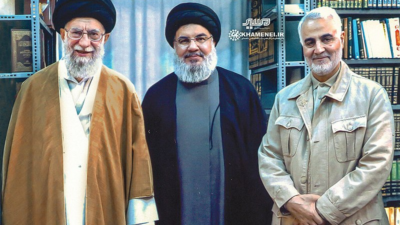Introduction
Iran’s recent ballistic missile attack against Israel (Oct 2024) in revenge for the killing of Hezbollah leader Hassan Nasrallah led to a flurry of excitement in the Muslim world. For many, Iran is seen as the bravest country in the Muslim world, standing alone against Israel.
Every sincere Muslim wants to see the liberation of Palestine and the end of Zionism. The attack on Gaza has demonstrated to the world the psychopathic genocidal nature of the Israeli state. Its evil is plain to see. As for Iran, its enmity towards Islam and Muslims has been far more subtle. Iran’s anti-Israeli and anti-Western rhetoric has led unsuspecting Muslims to believe that it is a champion of their cause against Zionism and imperialism.
This is far from the truth. To understand why, it is essential to study both the history and ideology of Shi’ism and the recent history of Iran. This article focuses on the latter, providing a very brief overview of key geopolitical events involving Iran and its relations with other Muslim countries over the past 30 years. I begin with the 1979 Shi’i revolution in Iran, a pivotal event that had profound effects on the Middle East and beyond.
The 1979 Iranian revolution
Until 1979 Iran was ruled by Muhammad Shah Reza Pahlavi, a secular, pro-Western dictator. Various groups and factions within Iran revolted against the Shah, but it was the charismatic Ayatollah Khomeini who ultimately led the revolution to success. He immediately established a theocratic government based on Shi’i principles and declared himself Supreme Leader. Khomeini became the first person in the 1400-year history of Shiism to declare himself as both the highest religious authority and the undisputed head of state. While this departure from traditional Shi’i jurisprudence was opposed by many scholars, it was a shrewd move by Khomeini to consolidate his power.
Khomeini’s rule was marked by ruthless oppression of his political opponents. On the international stage, he positioned himself as the leader of all Muslims, regardless of whether they were Sunni or Shi’i, and called for Muslim unity against common enemies. However, domestically, the situation was vastly different. Khomeini oversaw a systematic and brutal persecution of Iranian Sunnis.
Immediately upon seizing power, Khomeini’s regime began systematically executing senior Sunni scholars, imprisoning or exiling others, destroying Sunni mosques, and carrying out massacres of Sunnis throughout the country. Sunnis were removed from all senior government positions, and the constitution was amended to exclude Sunnis from any meaningful political participation. In Tehran, which has a population of one million Sunnis, not a single Sunni masjid remains. Sunnis in Tehran are still banned from holding Eid prayers. Khomeini’s heretical beliefs, including his description of Umm al-Mu’mineen A’ishah as being “more impure than dogs and pigs,” (Kitab Al Tahaarah of Ayatollah Khomeini – Vol. 3, p. 457) led many scholars to take him outside the fold of Islam.
The Iran- Iraq war and the Israeli connection
Almost immediately after the 1979 Shi’i revolution, Iran and Iraq were at war. The causes of this war were complex, rooted in long-standing border disputes. However, upon seizing power, Khomeini immediately began destabilizing Iraq by supporting the separatist (and secular) Kurds, openly calling for Iraqi Shias to revolt and form a private Shi’i army, supporting the Iraqi Shi’i Dawah Party which carried out multiple terrorist attacks, attempting to assassinate the Deputy Prime Minister of Iraq, assassinating twenty senior Iraqi officials, and committing over 500 border violations.
In September 1980, Iran shelled several populated cities in Iraq and closed off the Shatt al Arab waterway, blocking Iraq’s only access to the Gulf. As later stated by Iran’s first foreign minister Ebrahim Yazdi, Khomeini intentionally provoked a war with Iraq. On September 22, 1980, Iraq invaded Iran. A week later, UN Resolution 479 called for an immediate end to the conflict. Iraq immediately accepted the resolution and offered to withdraw from any Iranian territory, but Khomeini refused a ceasefire.
In 1982, as Israel prepared to invade Lebanon, Iraqi leader Saddam Hussein extended a peace offer to Iran, proposing a united front against the common enemy Israel. However, Khomeini rejected the offer, declaring that “the road to Qods (Jerusalem) went through Karbala, Iraq” thus emphasizing Iran’s determination to establish a Shi’a-dominated state in Iraq. Iran’s continual rejection of a ceasefire resulted in a devastating eight-year war with Iraq. The conflict caused immense human suffering, with over one million casualties on both sides and a combined financial loss estimated at $1 trillion dollars.
An intriguing aspect of this war is the role played by Israel. Trita Parsi, an Adjunct Professor of International Relations at Johns Hopkins University, explores this topic in depth in his acclaimed book “Treacherous Alliance: The Secret Dealings of Israel, Iran, and the United States”. In the book, Parsi presents compelling evidence suggesting a covert alliance between Iran and Israel. Parsi states in pages 104-7.
“Throughout the 1980s, no one in Israel said anything about an Iranian threat—the word wasn’t even uttered,” said Professor David Menashri of Tel Aviv University, Israel’s foremost expert on Iran.
A majority of senior Israeli officials, including Yitzhak Rabin, continued to believe that Iran was a “natural ally” of Israel. Stopping Saddam was paramount, and if ‘that meant going along with the request for arms by the Iranians, and that could prevent an Iraqi victory, so be it’, asserted David Kimche, former head of the Israeli Foreign Ministry.
Israeli Foreign Minister Moshe Dayan urged the United States to help Iran keep up its defences. Israel moved swiftly on several fronts. In Zurich, Iranian and Israeli officials met to conclude an arms deal. Israeli Col. Ben-Youssef and his Iranian counterpart, Col. Zarabi, discussed an agreement that would allow Israeli technicians to train the Iranian army in retooling and refitting Iran’s American-made weapons for Israeli-made parts”.
Parsi further explains that in June 1981, eight Israeli F-16s and six F-15s, guided by Iranian intelligence, successfully destroyed the Iraqi nuclear research reactor at Osirak. This daring operation was facilitated by Iran’s assurances that Israeli planes would be allowed to land at an Iranian airfield in Tabriz in case of an emergency.
“All in all, according to Ahmad Haidari, an Iranian arms dealer working for the Khomeini regime, roughly 80 percent of the weaponry bought by Tehran immediately after the onset of the war originated in Israel. Iran purchased over $500 million worth of arms from Israel in the 1980–1983 period. Most of it was paid for through deliverance of Iranian oil to Israel”.
Iran and Israel have often found themselves drawn to each other due to common strategic interests. In his book, Deterrence without the Bomb: The Politics of Israel’s Strategy, Avner Yaniv convincingly argues that the relationship between Israel and Iran is enduring, stating that:
“It is difficult to ignore the strength and fundamental durability of the Israeli connection with Iran. Whatever the regime, the response of [Iran and Israel] to the age-old rules of balance-of-power game keeps leading them into each other’s embrace. The mutual interest may be limited, but it has been real enough all along”.
(taken from Sobhani 161-2).
Sobhani in the conclusion of his book The Pragmatic Entente Israeli–Iranian Relations, 1948–1988, underscores the mutually beneficial relationship between Israel and Iran. He suggests that due to their geopolitical positions, each country views the other as a potential asset in balancing against their more immediate adversaries. The pragmatic nature of their relationship is driven by strategic interests, such as counterbalancing regional rivals or addressing shared threats. (Sobhani 170-1)
Iran’s Betrayal in Afghanistan
In the aftermath of the September 11th attacks, the United States launched its so called “war on terror”, targeting the Taliban government in Afghanistan. Prior to the US led invasion Iran had been a staunch supporter of the Northern Alliance, a group of anti-Taliban forces. Post-9/11, Iran maintained its support for the Northern Alliance while also offering assistance to the United States. Iran’s support was multifaceted, including providing valuable intelligence on Taliban leadership, military positions, and supply lines. Iran also granted the United States access to its air bases and infrastructure, significantly aiding logistical efforts.
Furthermore, Iran coordinated with U.S. ground forces, sharing information on Taliban movements and participating in joint operations. Additionally, Iran facilitated communication between the United States and Afghan opposition groups (Parsi: Treacherous Alliance pp 223-234).
Due to Iran’s support, the United States was able to establish a military presence in Afghanistan, install a client government and gain access to the country’s natural resources.
Slaughter in Iraq
Iran’s longstanding ambition to spread Shi’ism throughout the region has had catastrophic consequences for the Sunni population of Iraq. This goal was significantly advanced by the 2003 U.S.-led invasion of Iraq, which, despite warnings from U.S. policymakers, created a power vacuum that Iran eagerly exploited. The US invasion of Iraq served Iran’s strategic objectives. By destabilizing Iraq and removing its traditional regional rival, Iran gained a prime opportunity to expand its influence and establish a Shi’a-dominated state.
The ensuing years witnessed a systematic campaign of ethnic cleansing against the Sunni minority, orchestrated by Iranian-backed Shi’i militias. These militias employed brutal tactics, including targeted killings, bombings, and threats of violence, to drive Sunnis from their homes and communities. The Iranian-backed Shi’i militias also seized property and businesses owned by Sunnis, further marginalizing them. In some cases, entire neighbourhoods were emptied of Sunni residents. As a result, hundreds of thousands of Sunnis were forced to flee or were killed. Many Sunnis changed their names to avoid being killed. The Shi’i dominated Iraqi government was often complicit in the ethnic cleansing, either by turning a blind eye to the militias’ activities or by actively supporting them..
Iran and Syria
The Syrian civil war, which began in 2011, is a complex and ongoing conflict. While a detailed analysis of this devastating war is beyond the scope of this article, I will focus on the significant role played by Iran and its proxies.
As soon as the conflict began Iran dispatched Qasim Suleimani, a prominent Iranian military leader, to Syria. His first step was to release thousands of takfiris from Syrian prisons, in order to sow discord among the Syrian opposition. Second, he provided military support to the Syrian government, including training, equipment, and personnel.
Iran then formed the Shiite Liberation Army (SLA), a coalition of Shiite militias from Iraq, Afghanistan, and Pakistan. They fought alongside thousands of Hezbollah fighter although the latter had its own leadership and structure. Both the SLA and Hezbollah were involved in a range of human rights abuses against Sunnis, including indiscriminate violence against civilians, the use of torture, and forced displacement.
In 2012 Qassem Suleimani orchestrated a fierce offensive on Aleppo, a strategic city that had fallen to rebel forces. Thousands of Hezbollah and SLA fighters joined the assault, backed by Russian airstrikes. The siege of Aleppo lasted from 2012 to 2016 and was marked by extreme brutality, with the regime employing tactics like starvation and indiscriminate bombardment, resulting the deaths of an estimated 31,000 people. It was one of the longest and bloodiest sieges in modern warfare.
Driven by its sectarian ambitions to expand Shi’i influence in the region, Iran exploited the Syrian civil war to reshape Syria’s demographics in its favour. Foreign Shi’i populations have now settled in areas abandoned by fleeing Sunnis. Ethnic cleansing is employed to create a solid Shiite bloc, especially along strategic routes leading to Lebanon. Tactics like “starve or surrender” have been frequently used, where Sunni neighbourhoods are besieged and food delivery is prevented, forcing residents to agree to repatriation.
Iran and Hezbollah have employed a carrot-and-stick approach to promote Shi’ism among the Sunni Syrian population. They offer financial assistance, education opportunities, and social services to Sunnis who convert, whilst using threats and intimidation to coerce them into choosing between conversion and persecution.

Supreme leader Ayatollah Ali Khamenei (left), Hezbollah Secretary General Hassan Nasrallah (centre), and Qods Force commander Qasem Soleimani (right). This photo is believed to have been taken in Tehran. Taken from from the Ali Khamenei website, https://english.khamenei.ir/news/7074/Untold-facts-on-Israel-Hezbollah-war-in-an-interview-with-Major
Iran’s immediate goal in Syria is to establish a land corridor between the Iranian border and the Mediterranean Sea, which permanently excludes all Sunnis. This is part of its broader strategy to create a Shi’i-dominated region in the Middle East. Through its brutal three-pronged strategy of forcing Sunnis to either convert to Shiasm, face expulsion, or be killed, Iran has strengthened its political and religious influence in the region. Iran has also created political parties out of the Shi’i militias, leading to an Iranian-run “parallel state” in Syria.
What drives Iran’s foreign policy?
Iran’s foreign policy is shaped by Shi’i theology and its deep-seated hostility to ahlul-sunnah. The Iranian Revolution of 1979 sought not only to establish a Shi’i state in Iran but also to export Shi’asm to other Muslim countries. I will now briefly summarise this theology.
Shi’ism is a religion built on the belief that almost all of the Companions of Allah’s Messenger (salalahu alaihi wa sallam) apostated after his death, a total rejection of the prophetic hadith, and in the case of most Shi’i scholars, the belief that the Quran was been distorted by the Sahaabah.
Another cornerstone of Shi’a belief is their concept of the hidden Imam (Mahdi). The prominent Shi’a scholar Muhammad Baqir al-Majlisi (d. 1699) authored a monumental 114-volume collection of Shi’a traditions titled Bihar al-Anwar. This work offers a chilling portrayal of the Shia belief in the Mahdi’s actions when he emerges from his cave in Samarra.
“Majlisi states:
“The first thing the Mahdī will start with is that he will extract these two (Abu Bakr and Umar) from their graves fresh and kicking. He will burn them and scatter their ashes in the air and demolish the Masjid (Nabawi)”.
(Biḥār al-Anwār 52/386).
Following the punishment of Abu Bakr and Umar, their Mahdi will turn his attention to Umm al-Mu’mineen ‘A’ishah.
“Behold, when our Mahdī will emerge, Ḥumayraa’ (a title of ʿA’ishah) will be brought to him so that he may execute the punishment upon her (for adultery).” Biḥār al-Anwār 52/314-315).
Other reports mention that their Mahdi will kill the Arabs, destroy the Ka’bah, destroy the Prophet’s Mosque; he will call people to a new religion, a new book and new laws; and he will conquer cities with the Ark of the Covenant of the Jews, and he will rule according to the law of the family of Dawood (summarised from Biḥār al-Anwār, al-Nuʿmānī’s Kitāb al-Ghaybah and Sallabi).
These reports in essence expose what Iran and its proxies desire to accomplish if they are given the opportunity to rule and dominate the Muslim world.
Israel and Iran need each other. It has always been this way and will always remain the same.
—Israeli analyst, 1986
Summary
The relationship between Israel and Iran is a complex and nuanced one, and Muslims should not be overly excited by Iran’s recent missile attack against Israel. Although the attack damaged several Israeli airbases, Iran deliberately avoided attacking densely packed IDF ground forces bases.
The current conflict between Iran and Israel needs to be viewed in light of both countries’ long-term mutual strategic goals. Iran and Israel fear a true Islamic revival upon the prophetic methodology as this would spell the end for both Zionism and Shia expansionism. It is this shared concern that will determine their long-term relationship.
Dr. Farasat Latif
References
The Biography of Ali ibn Abi Talib (2 volumes). Ali Muhammad Sallabi (Darussalam 2011)
The Pragmatic Entente: Israeli–Iranian Relations, 1948–1988. Sohrab Sobhani (New York: Praeger, 1989).
Treacherous Alliance: The Secret Dealings of Israel, Iran, and the United States. Trita Parsi (New Haven, Yale University Press, 2007).
Taḥqiq̄ Mawāqif al-Ṣaḥābah fil̄ -Fitnah. Sayyid Muḥammad Amaḥzūn (English translation by (mahajjah.com. n.d)
A Comprehensive Study of the Shah creed. Doctor Nāṣir ibn ʿAbd Allāh al-Qaffāri. (mahajjah.com. n.d)
History And Evolution of Shi’ism. Shaykh Iḥsān Ilāhī Ẓahīr (Maḥajjah Research Institute, 2023)
https://www.meforum.org/middle-east-quarterly/tehran-shiification-of-syria
http://islamicweb.com/beliefs/cults/shia_dismal_iran.htm
https://www.theguardian.com/world/2006/oct/10/iraq.peterbeaumont
https://www.al-monitor.com/originals/2017/09/iran-tehran-sunni-mosque-prayer-space-pounak.html
https://iranwire.com/en/fact-checking/71310/.
https://www.latimes.com/archives/la-xpm-2006-sep-28-fg-intel28-story.html






Informative and insightful, with well-researched, factual information.
jazaakallakhair